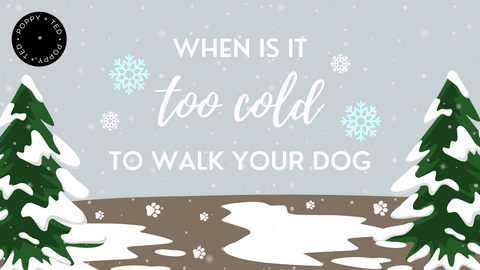The Winter months bring with them chilly temperatures, and while some dogs revel in the snow, it's crucial to understand the ideal conditions for safe outdoor activities. You never want to push your dog beyond their limits, especially as they can’t communicate with you beyond shivering when they’re feeling the harsh sting of a cold and miserable day. To help you get a better idea of when you should avoid taking your dog out in the cold this winter.
What Temperature is Too Cold to Walk My Dog?
The tolerable temperature for dogs varies based on breed, size, and coat type. Generally, most dogs can handle temperatures around 7°C to 0°C comfortably. Smaller breeds, older dogs, and those with shorter coats might need extra protection in colder weather.
A good rule of thumb to follow is to avoid taking your dog out if it’s too cold for you. If you’re struggling to stay warm outdoors, your dog will likely have the same issue. However, if you need specific numbers, keep in mind that no dog should be walked outside in temperatures below -9°C. For short-haired dogs, this should be higher at -4°C.
Beyond Temperature:
It’s also important to follow your instincts when it comes to walking your dog in the cold and not blindly follow the forecast. Consider the wind chill and humidity. A breezy day can significantly lower the "feels-like" temperature for both humans and pets. Additionally, the duration of exposure matters; extended periods in the cold can affect even cold-tolerant breeds.
Factors Affecting Tolerance:
Factors such as your dog's health, age, and fitness level impact their cold tolerance. Older dogs and those with health issues might struggle in colder temperatures and require shorter walks or extra insulation.
Signs and Symptoms of Cold Stress in Dogs
So, what if you have taken your dog for their daily walk and temperatures start to drop? You might be halfway through your usual route before you realise it is too cold to take your dog out. Well, these are the signs that your dog is feeling the bitter chill, and you need to get them warmed up ASAP:
- Shivering: Like humans, your dog will shiver when they are too cold. An easy sign to spot!
- Cold Ears: When we’re too cold, we usually feel it in our hands first. For dogs, it's their ears.
- Stiff Movements: If you notice your dog starts to walk more stiffly during their walk, this is a sign they’re feeling lethargic and having trouble walking in the cold temperatures.
- Whining: Your dog can’t use words to let you know they’re too cold, but they can whine and will often vocalise and cease moving if they can’t handle the cold any longer.
Hypothermia in Dogs
If your dog is exposed to extremely cold temperatures for too long, they can get hypothermia. Signs to look out for include a rapid drop in temperature, slow breathing and becoming unresponsive. In extreme instances, they may even collapse.
If you’re concerned that your dog has hypothermia, warm them up gradually using a heating pad or hot water bottle and seek urgent veterinary care.
Frostbite on Dogs
It is also possible for your dog to get frostbite if outside in the cold for too long, in which case you also need to get them warm, dry, and to the vet as a matter of emergency. Here are the signs of frostbite to look out for:
- Blue Skin: Your dog’s skin may appear grey with a blue tinge. You should part their hair to examine the skin in different places around the body.
- Cold to the Touch: If your dog’s skin remains cold to the touch even after bringing them back indoors and applying your body heat, it could be a sign of frostbite.
- Swelling: As our dog flesh freezes, it also swells, so look out for noticeable swelling after a cold walk. It may also be painful to the touch.
- Blisters: Your dog’s frozen skin will start to blister depending on the severity of the frostbite.
- Blackened Skin: Prolonged exposure to freezing conditions will eventually kill the tissue. Changing from a blue colour to black.
Remember to look out for signs of frostbite on the paws, tail and ears first, as these areas are most exposed to the cold.
Prioritise Your Pup's Warmth: Explore Our Winter Essentials Collection
As much as our furry friends love their walks, it's crucial to recognise the dangers of extreme cold on their well-being. Knowing the signs of discomfort, frostbite, and hypothermia is vital to keeping them safe during winter outings. Remember, when it's too cold for you, it's likely too cold for your dog!
Prioritise their warmth and comfort by exploring our curated collection of dog fleeces, cosy blankets, and snug harnesses designed to keep them snug and protected during chilly walks and when they come home. Let's make this winter a season of warmth and joy for both you and your beloved canine companion.
Related Articles
Walking Your Dog In Winter: The Do’s and Dont’s
Hiking With Dogs: How to Prepare and Stay Safe
Why Won’t My Dog Walk? Tips and Advice for Reluctant Walkers


